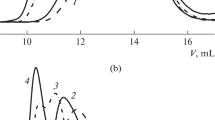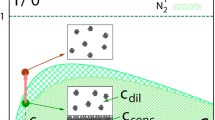Abstract
Three polysilane polymers, (n-PrSiMe) n , (i-PrSiMe) n , and (sec-BuSiMe) n , were synthesized and characterized by DSC. UV spectroscopy, wide-angle X-ray diffraction, and optical microscopy, all at variable temperatures. The known thermochromic transition of (n-PrSiMe) n at ∼48 C is associated with a change from an orthorhombic to an isotropic phase. (i-PrSiMe) n was examned as an insoluble and soluble (lowM w) fraction, both existing mainly in an orthohombic lattice at room temperature. (sec-BuSiMe) n has a mesophase structure at 25 C, undergoes a weak endothermic transition to a second (nematic) mesophase near 65 C, and becomes isotropic at ∼160 C.
Similar content being viewed by others
References
For reviews see R. D. Miller and J. Michl,Chem. Rev. 89, 1357 (1989); R. West, inThe Chemistry of Organic Silicon Compounds, S. Patai and Z. Rappoport, eds. (Wiley-Interscience, Chichester, UK. 1989). Chap. 19; R. West, inComprehensive Organometallic Chemistry, 2nd ed. (1994), in press.
L. H. Harrah and J. M. Zeigler,Macromolecules 20, 601 (1987); Y.-P. Sun, R. D. Miller, R. Sooriyakumaran, and J. Michl,J. Inorg. Organomet. Polym. 1, 3 (1991): J. W. Mintmire.Phys. Rev. B 39, 13350 (1984).
A. J. Lovinger, F. C. Schilling, F. A. Bovey, and J. M. Zeigler,Macromolecules 19, 2657, 2660 (1986); F. C. Schilling, A. J. Lovinger, J. M. Zeigler, D. D. Davis, and F.A. Bovey,Macromolecules 22, 3055 (1989).
E. K. Karikari, A. J. Greso, B. L. Farmer, R. D. Miller, and J. F. Rabolt,Macromolecules,26, 3937 (1993).
T. Asuke and R. West,Macromolecules 24, 344 (1991).
C.-H. Yuan and R. West,Macromolecules 27, 629 (1994).
P. Dave, S. C. Israel, and S. P. Sawan,Polym. Preprints 31, 566 (1990).
P. Trefonas, P. I. Djurovich, X.-M. Zhang, R. West, R. D. Miller, and D. Hofer,J. Polym. Sci. Polym. Lett. Ed. 21, 819 (1983).
M. A. Abu-Eid, R. B. King, and A. M. Kotliar,Eur. Polym. J. 28, 315 (1992); T. Karatsu, H. Kobayashi, E. Shinkai, and A. Kitamura,Chem. Lett. 2134 (1992); R. D. Miller, M. Baier, A. F. Diaz, E. J. Ginsburg, and G. M. Wallraff,Pure Appl. Chem. 64, 1291 (1992); H. Ban and K. Sukegawa,J. Polym. Sci. Polym. Chem. Ed. 26, 521 (1988); M. Fujino and H. Isaka,J. Chem. Soc. Chem. Commun. 466 (1989); G. E. Johnson and K. M. McGrane, ACS Symposium Series No. 358 (1987), p. 499; F. C. Schilling, F. A. Bovey, and J. M. Zeigler,Macromolecules 19, 2309 (1986); K. S. Schweitzer, L. A. Harrah, and J. M. Zeigler,Adv. Chem. Ser. 224, 379 (1990); A. R. Wolff, J. Maxka, and R. West,J. Polym. Sci. Polym. Chem. Ed. 26, 713 (1988); R. G. Kepler, and J. M. Zeigler,Mol. Cryst. Liq. Cryst. 175, 85 (1988); A. F. Diaz, M. Baier, G. M. Wallraff, R. D. Miller, J. Nelson, and W. Pietro,J. Electrochem. Soc. 138, 742 (1991); S. Irie, and M. Irie,Macromolecules 25, 1766 (1992); S. Tagawa,J. Photopolym. Sci. Technol. 4, 231 (1991); M. A. Abkowitz and M. Stolka,Synth. Met. 50, 395 (1992);Solid State Commun. 78, 269 (1991); S. Irie and M. Irie.Radiat. Phys. Chem. 40, 107 (1992); H. Yamashita and M. Tanaka,Chem. Lett. (1992) 1547; J. M. Zeigler, L. I. McLaughlin, and R. J. Perry,J. Inorg. Organomet. Polym. 1, 531 (1991); C.-L. Callender, C. A. Carere, J. Albert, L. L. Zhou, and D. J. Worsfold,J. Opt. Soc. Am. B. Opt. Phys. 9, 518 (1992).
K. Yokoyama and M. Yokoyama,Solid State Commun. 70, 241 (1989).
Since only three X-ray peaks were observed, the assignment of an orthorhombic lattice cannot be made certainly. The spacings are inconsistent with lattices of higher symmetry, but a monoclinic lattice remains as a possibility.
Although (n-HexSiMe) n is amorphous by X-ray diffraction at all temperatures, it undergoes a thermochromic transition from 325 to 298 nm as the temperature is increased from −40 to 0 C; see Ref. 6.
The closest analogy is probably with the orthorhombic structure of (Et2Si) n , with all-trans conformation andc=3.99 A. See A. J. Lovinger, D. D. Davis, F. C. Schilling, F. A. Bovey, and J. M. Zeigler,Polym. Commun. 30, 356 (1989).
T. Asuke and R. West,J. Inorg. Organomet. Polym. 4, 45 (1994).
Author information
Authors and Affiliations
Additional information
Dedicated to the memory of Professor Zygmunt Lasocki, a fine chemist and a kind and gentle person.
Rights and permissions
About this article
Cite this article
Asuke, T., West, R. Properties of some polysilane polymers: (n-PrSiMe) n , (i-PrSiMe) n , and (sec-BuSiMe) n . J Inorg Organomet Polym 5, 31–42 (1995). https://doi.org/10.1007/BF01157521
Received:
Revised:
Issue Date:
DOI: https://doi.org/10.1007/BF01157521




